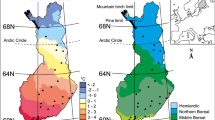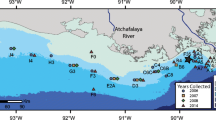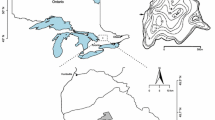Abstract
The ratio between chrysophycean cysts and diatom valves (CD ratio) in lake sediments has been suggested as a useful indicator of changing trophic state conditions in oligotrophic lakes. Other environmental factors, however, may influence the CD ratio because chrysophycean cysts usually reflect conditions in the planktonic environment and diatoms reflect benthic conditions. We investigated the CD ratio in 76 mountain lakes in the Pyrenees to determine the environmental drivers that influence the ratio and assess its value for paleoenvironmental inference. The lakes surveyed included a broad range with respect to bedrock type, altitude and surface area, characteristics that cover much of the variability that can be found in cold, oligotrophic mountain lakes. Lake depth and Ca2+ concentration explain most of the variation in the CD ratio. Trophic state factors (e.g. total phosphorus, TP) play a secondary role. As a predictor, CD ratio performs primarily as a lake depth indicator. The predictive models can be improved if trophic state (i.e. TP) and chemical conditions (Ca2+) are known or can be estimated independently. Use of the CD ratio for inferring Ca2+ oscillations only makes sense in lakes with Ca2+ <200 µeq/L or in those that oscillate below and above this threshold through time. Other interpretations of the CD ratio (e.g. lake trophic state changes, ice-cover duration) make sense if complementary paleolimnological evidence indicates that neither water depth nor Ca2+ concentration changed significantly. Indeed, paleolimnological interpretation of the CD ratio requires considering the particular characteristics of the lake and may vary depending on the temporal scale considered. This study provides some guidelines for evaluating critically the use of the CD ratio.






Similar content being viewed by others
References
Ardiles V, Alcocer J, Vilaclara G, Oseguera LA, Velasco L (2012) Diatom fluxes in a tropical, oligotrophic lake dominated by large-sized phytoplankton. Hydrobiologia 679:77–90
Barker P, Fontes JC, Gasse F, Druart JC (1994) Experimental dissolution of diatom silica in concentrated salt solutions and implications for paleoenvironmental reconstruction. Limnol Oceanogr 39:99–110
Battarbee RW, Jones V, Flower R, Cameron N, Bennion H (2001) Diatoms. In: Smol JP, Birks HJ, Last WM (eds) Tracking environmental change using lake sediments: vol 3: terrestrial, algal, and siliceous indicators. Springer, Berlin, pp 155–202
Camarero L, Rogora M, Mosello R, Anderson NJ, Barbieri A, Botev I, Kernan M, Kopáček J, Korhola A, Lotter AF, Muri G, Postolache C, StuchlÍk E, Thies H, Wright RF (2009) Regionalisation of chemical variability in European mountain lakes. Freshw Biol 54:2452–2469
Cameron NG, Birks HJB, Jones VJ, Berge F, Catalan J, Flower RJ, Garcia J, Kawecka B, Koinig KA, Marchetto A, Sanchez-Castillo P, Schmidt R, Sisko M, Solovieva N, Stefkova E, Toro M (1999) Surface-sediment and epilithic diatom pH calibration sets for remote European mountain lakes (AL: PE Project) and their comparison with the Surface Waters Acidification Programme (SWAP) calibration set. J Paleolimnol 22:291–317
Catalan J, Ventura M, Brancelj A, Granados I, Thies H, Nickus U, Korhola A, Lotter AF, Barbieri A, Stuchlik E, Lien L, Bitusik P, Buchaca T, Camarero L, Goudsmit GH, Kopacek J, Lemcke G, Livingstone DM, Muller B, Rautio M, Sisko M, Sorvari S, Sporka F, Strunecky O, Toro M (2002) Seasonal ecosystem variability in remote mountain lakes: implications for detecting climatic signals in sediment records. J Paleolimnol 28:25–46
Catalan J, Barbieri MG, Bartumeus F, Bitusik P, Botev I, Brancelj A, Cogalniceanu D, Manca M, Marchetto A, Ognjanova-Rumenova N, Pla S, Rieradevall M, Sorvari S, Stefkova E, Stuchlik E, Ventura M (2009a) Ecological thresholds in European alpine lakes. Freshw Biol 54:2494–2517
Catalan J, Curtis CJ, Kernan M (2009b) Remote European mountain lake ecosystems: regionalisation and ecological status. Freshw Biol 54:2419–2432
Chen G, Dalton C, Leira M, Taylor D (2008) Diatom-based total phosphorus (TP) and pH transfer functions for the Irish Ecoregion. J Paleolimnol 40:143–163
Cremer H, Bunnik FM, Kirilova E, Lammens ERR, Lotter A (2009) Diatom-inferred trophic history of IJsselmeer (The Netherlands). Hydrobiologia 631:279–287
Cumming BF, Wilson SE, Smol JP (1993) Paleolimnological potential of chrysophyte cysts and scales and of sponge spicules as indicators of lake salinity. Int J Salt Lake Res 2:87–92
de Mendoza G, Catalan J (2010) Lake macroinvertebrates and the altitudinal environmental gradient in the Pyrenees. Hydrobiologia 648:51–72
DeNicola DM, De Eyto E, Wemaere A, Irvine K (2004) Using epilithic algal communities to assess trophic status in Irish lakes. J Phycol 40:481–495
Douglas MSV, Smol JP (1995) Paleolimnological significance of observed distribution patterns of chrysophyte cysts in arctic pond environments. J Paleolimnol 13:79–83
Duff K, Zeeb BA, Smol JP (1995) Atlas of chrysophycean cysts. Kluwer Academic Publishers, Dordrecht
Ferris JA, Lehman JT (2007) Interannual variation in diatom bloom dynamics: roles of hydrology, nutrient limitation, sinking, and whole lake manipulation. Water Res 41:2551–2562
Gomes DF, Albuquerque ALS, Torgan LC, Turcq B, Sifeddine A (2014) Assessment of a diatom-based transfer function for the reconstruction of lake-level changes in Boqueirão Lake, Brazilian Nordeste. Palaeogeogr Palaeoclimatol Palaeoecol 415:105–116
Hadley KR, Douglas MSV, Lim D, Smol JP (2013) Diatom assemblages and limnological variables from 40 lakes and ponds on Bathurst Island and neighboring high Arctic islands. Int Rev Hydrobiol 98:44–59
Hadley KR, Paterson AM, Stainsby EA, Michelutti N, Yao H, Rusak JA, Ingram R, McConnell C, Smol JP (2014) Climate warming alters thermal stability but not stratification phenology in a small north-temperate lake. Hydrol Process 28:6309–6319
Hall RI, Leavitt PR, Smol JP, Zirnhelt N (1997) Comparison of diatoms, fossil pigments and historical records as measures of lake eutrophication. Freshw Biol 38:401–417
He Y, Zhao C, Sun Y, Song M, Liu Z, Zheng Y, Zheng Z, Pan A (2014) Biomarker-based reconstructions of Holocene lake-level changes at Lake Gahai on the northeastern Tibetan Plateau. Holocene 24:405–412
Hobæk A, Løvik JE, Rohrlack T, Moe SJ, Grung M, Bennion H, Clarke G, Piliposyan GT (2012) Eutrophication, recovery and temperature in Lake Mjøsa: detecting trends with monitoring data and sediment records. Freshw Biol 57:1998–2014
Jong R, Kamenik C, Westover K, Grosjean M (2013) A chrysophyte stomatocyst-based reconstruction of cold-season air temperature from Alpine Lake Silvaplana (AD 1500–2003); methods and concepts for quantitative inferences. J Paleolimnol 50:519–533
Keatley BE, Douglas MSV, Smol JP (2008) Prolonged ice cover dampens diatom community responses to recent climatic change in high Arctic lakes. Arct Antarct Alp Res 40:364–372
Koinig KA, Kamenik C, Schmidt R, Agustí-Panareda A, Appleby P, Lami A, Prazakova M, Rose N, Schnell ØA, Tessadri R, Thompson R, Psenner R (2002) Environmental changes in an alpine lake (Gossenköllesee, Austria) over the last two centuries—the influence of air temperature on biological parameters. J Paleolimnol 28:147–160
Legendre P, Legendre L (2012) Numerical ecology. Elsevier, Amsterdam
Leira M, Cantonati M (2008) Effects of water-level fluctuations on lakes: an annotated bibliography. Hydrobiologia 613:171–184
Lotter AF, Bigler C (2000) Do diatoms in the Swiss Alps reflect the length of ice-cover? Aquat Sci 62:125–141
Lowe RL (1996) Periphyton patterns in lakes. In: Stevenson JR, Bothwell ML, Lowe RL (eds) Algal ecology. Academic Press, San Diego, pp 57–76
Luoto TP (2009) A Finnish chironomid- and chaoborid-based inference model for reconstructing past lake levels. Q Sci Rev 28:1481–1489
Magny M (2001) Palaeohydrological changes as reflected by lake-level fluctuations in the Swiss Plateau, the Jura Mountains and the northern French Pre-Alps during the Last Glacial-Holocene transition: a regional synthesis. Global Planet Change 30:85–101
Magny M, Vannière B, de Beaulieu J-L, Bégeot C, Heiri O, Millet L, Peyron O, Walter-Simonnet AV (2007) Early-Holocene climatic oscillations recorded by lake-level fluctuations in west-central Europe and in central Italy. Quat Sci Rev 26:1951–1964
Magny M, Peyron O, Sadori L, Ortu E, Zanchetta G, Vannière B, Tinner W (2012) Contrasting patterns of precipitation seasonality during the Holocene in the south- and north-central Mediterranean. J Quat Sci 27:290–296
McCabe SK, Cyr H (2006) Environmental variability influences the structure of benthic algal communities in an oligotrophic lake. Oikos 115:197–206
Michelutti N, Smol JP, Cooke CA, Hobbs WO (2015a) Climate-driven changes in lakes from the Peruvian Andes. J Paleolimnol 54:153–160
Michelutti N, Wolfe AP, Cooke CA, Hobbs WO, Vuille M, Smol JP (2015b) Climate change forces new ecological states in tropical Andean lakes. PLoS ONE. doi:10.1371/journal.pone.0115338
Millet L, Rius D, Galop D, Heiri O, Brooks SJ (2012) Chironomid-based reconstruction of Lateglacial summer temperatures from the Ech palaeolake record (French western Pyrenees). Palaeogeogr Palaeoclimatol Palaeoecol 315–316:86–99
Moos MT, Laird KR, Cumming BF (2005) Diatom assemblages and water depth in Lake 239 (Experimental Lakes Area, Ontario): implications for paleoclimatic studies. J Paleolimnol 34:217–227
Nicholls KH (1995) Chrysophyte blooms in the plankton and neuston of marine and freshwater systems. In: Sandgren CD, Smol JP, Kristiansen J (eds) Chrysophyte algae. Cambridge University Press, Cambridge, pp 181–213
Olrik K (1998) Ecology of mixotrophic flagellates with special reference to Chrysophyceae in Danish lakes. Hydrobiologia 369–370:329–338
Pla S (2001) Chrysophycean cysts from the Pyrenees. J Cramer, Berlin
Pla S, Anderson NJ (2005) Environmental factors correlated with chrysophyte cyst assemblages in low arctic lakes of southwest Greenland. J Phycol 41:957–974
Pla S, Catalan J (2005) Chrysophyte cysts from lake sediments reveal the submillennial winter/spring climate variability in the northwestern Mediterranean region throughout the Holocene. Clim Dyn 24:263–278
Pla S, Camarero L, Catalan J (2003) Chrysophyte cyst relationships to water chemistry in Pyrenean lakes (NE Spain) and their potential for environmental reconstruction. J Paleolimnol 30:21–34
Pla S, Monteith D, Flower R, Rose N (2009) The recent palaeolimnology of a remote Scottish loch with special reference to the relative impacts of regional warming and atmospheric contamination. Freshw Biol 54:505–523
R Core Team (2015) R: a language and environment for statistical computing. R Foundation for Statistical Computing, Vienna, Austria
Rosseel Y (2012) Lavaan: an R package for structural equation modeling. J Stat Softw 48:1–36
Ryves DB, Juggins S, Fritz SC, Battarbee RW (2001) Experimental diatom dissolution and the quantification of microfossil preservation in sediments. Palaeogeogr Palaeoclimatol Palaeoecol 172:99–113
Saros JE, Anderson NJ (2015) The ecology of the planktonic diatom Cyclotella and its implications for global environmental change studies. Biol Rev 90:522–541
Shinneman ALC, Bennett DM, Fritz SC, Schmieder J, Engstrom DR, Efting A, Holz J (2010) Inferring lake depth using diatom assemblages in the shallow, seasonally variable lakes of the Nebraska sand hills (USA): calibration, validation, and application of a 69-lake training set. J Paleolimnol 44:443–464
Shuman B, Bravo J, Kaye J, Lynch JA, Newby P, Webb T (2001) Late Quaternary water-level variations and vegetation history at Crooked Pond, southeastern Massachusetts. Quat Res 56:401–410
Smol JP (1983) Paleophycology of a high arctic lake near Cape Herschel, Ellesmere Island. Can J Bot 61:2195–2204
Smol JP (1985) The ratio of diatom frustules to chrysophycean statospores: a useful paleolimnological index. Hydrobiologia 123:199–208
Smol JP (1995) Application of chrysophytes to problems in paleoecology. In: Sandgren CD, Smol JP, Kristiansen J (eds) Chrysophyte algae: ecology, phylogeny and development. Cambridge University Press, Cambridge, pp 303–330
The MOLAR Water Chemistry Group (1999) The MOLAR project: atmospheric deposition and lake water chemistry. J Limnol 58:88–106
Thompson R, Price D, Cameron N, Jones V, Bigler C, Rosén P, Hall RI, Catalan J, García J, Weckstrom J, Korhola A (2005) Quantitative calibration of remote mountain-lake sediments as climatic recorders of air temperature and ice-cover duration. Arct Antarct Alp Res 37:626–635
Tolotti M, Thies H, Cantonati M, Hansen CME, Thaler B (2003) Flagellate algae (Chrysophyceae, Dinophyceae, Cryptophyceae) in 48 high mountain lakes of the Northern and Southern slope of the Eastern Alps: biodiversity, taxa distribution and their driving variables. Hydrobiologia 502:331–348
Walker LR, Wardle DA, Bardgett RD, Clarkson BD (2010) The use of chronosequences in studies of ecological succession and soil development. J Ecol 98:725–736
Werner P, Smol JP (2005) Diatom–environmental relationships and nutrient transfer functions from contrasting shallow and deep limestone lakes in Ontario, Canada. Hydrobiologia 533:145–173
Wilkinson AN, Zeeb BA, Smol JP (2001) Atlas of chrysophycean cysts, vol II. Kluwer Academic Publishers, Dordrecht, p 180
Winder M, Reuter JE, Schladow SG (2009) Lake warming favours small-sized planktonic diatom species. P Roy Soc Lond B Biol Sci 276:427–435
Wright RF, Larssen T, Camarero L, Cosby BJ, Ferrier RC, Helliwell R, Forsius M, Jenkins A, Kopacek J, Majer V, Moldan F, Posch M, Rogora M, Schöpp W (2005) Recovery of acidified European surface waters. Environ Sci Technol 39:64A–72A
Yang J-R, Duthie HC (1995) Regression and weighted averaging models relating surficial sedimentary diatom assemblages to water depth in Lake Ontario. J Great Lakes Res 21:84–94
Zeeb BA, Smol JP (2001) Chrysophyte scales and cysts. In: Smol JP, Birks HH, Last WM (eds) Tracking environmental change using lake sediments, terrestrial, algal, and siliceous indicators. Kluwer Academic Publishers, Dordrecht, pp 203–223
Zeeb BA, Christie CE, Smol JP, Findlay DL, Kling HJ, Birks HJ (1994) Responses of diatom and chrysophyte assemblages in Lake 227 sediments to experimental eutrophication. Can J Fish Aquat Sci 51:2300–2311
Acknowledgements
This study was funded by the EU EMERGE Programme (EVK1-CT-1999-00032), the Spanish Government LACUS (CGL2013-45348-P) and CUL-PA (Parques Nacionales 998/2013). CRR was supported by a Ph.D. scholarship from the Departamento Administrativo de Ciencia, Tecnología e Innovación de Colombia (COLCIENCIAS-ICETEX-LASPAU, 070-2007) and the Pontificia Universidad Javeriana (DJE-025-2007).
Author information
Authors and Affiliations
Corresponding author
Rights and permissions
About this article
Cite this article
Rivera-Rondón, C.A., Catalan, J. The ratio between chrysophycean cysts and diatoms in temperate, mountain lakes: some recommendations for its use in paleolimnology. J Paleolimnol 57, 273–285 (2017). https://doi.org/10.1007/s10933-017-9946-2
Received:
Accepted:
Published:
Issue Date:
DOI: https://doi.org/10.1007/s10933-017-9946-2




